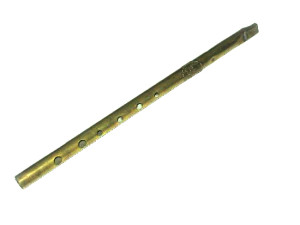
There are few instruments where the name itself has been derived from the material they are made of. The Tin whistle is one such- the guitar, piano, saxophone, clarinet, violin (to name just few) never had their names prefixed by the material they were made from. Perhaps the only other rare example is the instrument family known as brass instruments.
Of course the danger of naming an instrument after the material it is made of, is that sometimes that material changes! In fact the first whistles were made of hollow plant stalks – bamboo or similar – or sometimes even bone (vultures wing-bones were popular for this use 40,000 years ago).
The cultural history of the whistle, at least in Europe, does owe a lot to tin. Tin-smithing was an accessible and popular trade which involved an apprenticeship of 4-6 years with a master tinsmith – making cutlery, tin cups, baking tins candle holders and similar items. Before becoming master tinsmiths themselves many took to the road becoming journeymen and peddlers. Against this backdrop it’s easy to see how the tin whistle flourished – making use of the skills of the crafts-people while being portable – and the whistle will forever been associated with the traveler traditions of Europe.
So why has tin become less favourable as a material for making whistles from? If you look at some of the world’s top whistle makers – Chris Abell, Phil Hardy, Michael Burke, Colin Goldie, Michael Copland, – you’ll notice that none in fact use tin to make whistles from. The answer is really that the same qualities that made tin the favourable choice of material for several decades – it’s relatively soft and thin meaning that it could be cold rolled as well soldered – became detrimental when the tools available to the whistlesmith evolved. The advent of machine tools extended the possibilities – the lathe became the primary instrument of the whistle maker. Even gripping soft, thin, metal like tin, is awkward as the material deforms, never mind cutting it. Thicker more rigid materials became advantageous because they could be worked on more easily with the new tools available, and the thickness of the material could be used in new ways- to more control-ably form the airway and labium- the critical sound forming parts of a whistle. Of these materials – brass, steel & stainless steel, silver steel to name a few, aluminium became the most favourable because it is the easiest to form accurately, is strong, and yet light to aid resonance [though whistles rely a lot less on the resonance of the material than many other instruments, like a guitar for example]. In an instrument where the formation of the sound is much more dependent on its shape than the material used, then generally the material selection will be based on which it is easiest to form the desired shape with.
Bernard Overton’s aluminium Low Whistle of the 70s became the blue print for other low whistles- the birth (or perhaps rebirth) of this instrument was inherently linked to adoption of aluminium as a material to make whistles from. This has gradually filtered back to become the material of choice for high end tin (or high) whistle makers. While tin/copper or nickel are still used in cheaper whistles, which retain a very important place, the heads tend to plastic molded, and so don’t lend themselves to the iterative or experimental approach required for making high end musical instruments.
Perhaps the best thing however, is that despite the changes in materials over the decades and centuries, the whistle remains a relatively affordable musical instrument.
